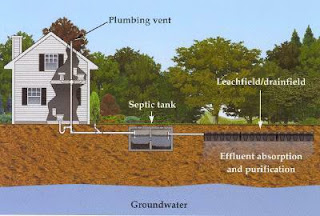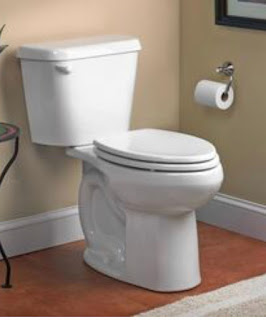LATERAL FIELD: Care and Maintenance
Today I will elaborate on the septic system drainfield and the best way to care for it.
In the diagram above, you can see all the components of a septic system. There is a tank and a leachfield/drainfield. When I talk to customers, many of them are confused as to what makes up a septic system. I would say many think that all they have is a tank and that is it. However, the bigger portion of the septic system (and also the most expensive part) is the leachfield/drainfield/lateral field. This part of the septic system is where the final treatment takes place and where every last drop of wastewater is absorbed from your home. It is important to know where your lateral field is located. If this portion of your system becomes damaged or inhibited in any way, it will ruin the functionality of your septic system.
Below are two examples of what is being installed today for lateral fields. The top picture is an example of EZ Flow lateral. The lower picture is an example of plastic gravelless chamber. Both of these types of systems behave in similar ways and have a similar set of rules to abide by to keep them safe and functioning properly.

There are several things I tell people about the care of their lateral field/drainfield. Here are the biggies:
1 Do not drive on your laterals with anything heavier than a lawnmower (or small 4 wheeler)
Looking at the pictures above, understand that eventually all these components will be covered with dirt and over time, should have nothing but grass growing on top. Though the black plastic chambers are hard and strong enough to the support the weight of your average man, it is not strong enough to withstand the weight of a car, truck or large vehicle. Those vehicles could crush it even under the ground. The same is true for the EZ Flow. Remember, the whole point of a lateral field is to “create air space” underground for water to collect. (It must act like a GIANT sponge!) If any part of the lateral field gets crushed, then the water that is collecting there, will start leaking to the surface.
Not good.
Very stinky.
Gross and bad.
Have I made my point?
2 Only plant grass or vegetation with short root systems on your lateral field
I love the bottom picture to show how a plastic chamber lateral field is laid out and installed, but what I do not like about this picture are all the trees surrounding it. One, you really don’t want to plant anything more than grass on top of your lateral field, but you also want to keep it away from trees too. The state guidelines suggest a minimum of 25 feet from trees as their root systems can extend extremely far. Roots can clog and ruin a lateral field too.
Again, not good...very stinky...gross and bad...etcetera, etcetera...
Do not build on top of your lateral field
Believe it or not, people forget where their lateral is and then will sometimes build on top of them. Please understand, this area needs to be kept open so it can breathe and evaporate the water it has been absorbing from your house. Nothing stops evaporation quite like a solid building!
If lateral can't absorb and evaporate bad things start to happen to the functionality of your system. Every system behaves a little bit differently depending on how many people live in the house and how much water is being used, but back ups into the house are going to be much more common if the lateral can't work properly. Meaning all that stuff that is supposed to LEAVE your house will start coming back into it! Not good...very stinky...gross and bad
And guess what can sometimes happen to the INSIDE of your building should you do this? It isn't good and it's very stinky...and I'm guessing you can finish the rest of my chorus, right?
4 Do not lay sprinkler lines on top of your lateral field. (Also, beware of runoff water).
If this area is supposed to absorb water and act like a sponge for both your home and from Mother Nature, do not “feed” it more water from a sprinkler system. If you constantly keep it wet, there will be nowhere for your water to go. This can lead to gross standing water on top of the laterals or back-ups into your home. Also, beware of how the guttering off your house drains. Make sure it bypasses this area so it can stay as dry as possible as often as possible.
I feel like we need to say it one more time, all together now! Sprinkler heads on the lateral field lead to standing icky water....very stinky....gross and bad!
I am trying to make light of something that really can be gross and hopefully easily avoided by sharing these points with you. Hope you enjoy the rest of your weekend! Until next time!




Comments
Post a Comment